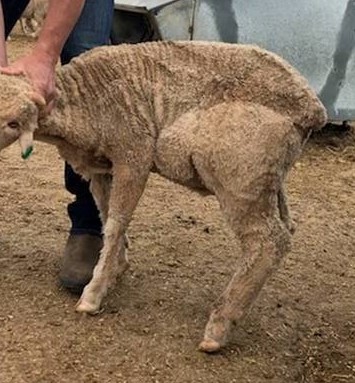A case of suspected Blackleg has been recently diagnosed in a lamb feedlot in South Australia. Black leg is caused by a clostridial bacterium which can survive for years in the soil and remain dormant without causing issues. Blackleg in sheep is often associated with a wounds such as shearing, tail docking, castration, injury to ewes during birthing, or infection of the navel in lambs soon after birth.
The bacteria enters the bloodstream and lodges in the muscle where it multiplies, causing inflammation of the muscle tissue. The legs are most commonly affected although any part of the body can become infected. In the recent case five lambs were affected; 4 were found with swollen back legs, and one with a swollen head. Blackleg causes the muscle tissue to become swollen, hot and painful, and turns a blackish red in colour, hence the name blackleg. Gas may form in the tissue making a crackling sound if it is pressed. Other symptoms may include fever, depression and loss of appetite and lameness if the infection is in the leg.

Toxaemia develops with very few sheep surviving once infected, and death usually occurs within 48 hours. It is advised to burn or deeply bury affected carcasses to prevent further contamination from spores surviving long term in the soil.
Blackleg is seldom diagnosed, however it may be a more common cause of death with the majority of South Australian producers vaccinating with a 3 in1 which covers Cheesy Gland, Tetanus and Pulpy Kidney, rather that the more expensive 6 in 1 that contains the antigens to prevent Blackleg.
In the recently diagnosed case the lambs were in a well-managed feedlot and had recently been given a triple action drench and vaccinated with a 3 in 1 on induction into the feedlot. The feedlot had been in the same location for 10 years and the producer had not previously seen evidence of Blackleg. It was difficult to determine in this case if the lambs arrived in the feedlot with dormant spores on board in the muscle or they picked up the spores from the soil. The affected lambs were not vendor bred and were sourced in local proximity to the feedlot and from interstate. Only two pens out of 10-15 pens were affected and the lambs were of mixed age and sex.
Intensification of sheep such as containment feeding or feedlotting increases the risk of the disease. In recent years the value of sheep and awareness of the benefits of containment feeding has increased the intensification of sheep in South Australia, creating an environment for Blackleg to potentially become more prevalent. Using a 6 in 1 vaccine requires two initial vaccinations 4-6 weeks apart followed by an annual booster. The owner of the feedlot in this case will look to vaccinate using a 6 in 1 during the induction phase for the next couple of years as a preventive.
This article was compiled by Tiffany Bennett with technical information from Dr Steph Warwick, Elders.